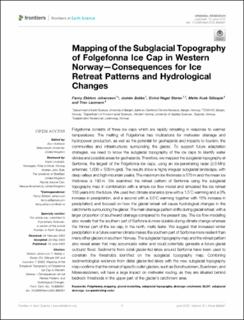| dc.contributor.author | Ekblom Johansson, Fanny | |
| dc.contributor.author | Bakke, Jostein | |
| dc.contributor.author | Støren, Eivind Wilhelm Nagel | |
| dc.contributor.author | Gillespie, Mette Kusk | |
| dc.contributor.author | Laumann, Tron | |
| dc.date.accessioned | 2022-10-07T13:20:01Z | |
| dc.date.available | 2022-10-07T13:20:01Z | |
| dc.date.created | 2022-08-31T09:25:42Z | |
| dc.date.issued | 2022-06-13 | |
| dc.identifier.issn | 2296-6463 | |
| dc.identifier.uri | https://hdl.handle.net/11250/3024559 | |
| dc.description.abstract | Folgefonna consists of three ice caps which are rapidly retreating in response to warmer temperatures. The melting of Folgefonna has implications for meltwater drainage and hydropower production, as well as the potential for geohazards and impacts to tourism, the communities and infrastructures surrounding the glacier. To support future adaptation strategies, we need to know the subglacial topography of the ice caps to identify water divides and possible areas for geohazards. Therefore, we mapped the subglacial topography at Sørfonna, the largest of the Folgefonna ice caps, using an ice-penetrating radar (2.5 MHz antennas; 1,000 × 500 m grid). The results show a highly irregular subglacial landscape, with deep valleys and high mountain peaks. The maximum ice thickness is 570 m and the mean ice thickness is 190 m. We examined the retreat pattern of Sørfonna using the subglacial topography map in combination with a simple ice flow model and simulated the ice retreat 150 years into the future. We used two climate scenarios (one with a 1.5°C warming and a 3% increase in precipitation, and a second with a 3.5°C warming together with 15% increase in precipitation) and focused on how the glacial retreat will cause hydrological changes in the catchments surrounding the glacier. The main drainage pattern shifts during glacial retreat, with a larger proportion of southward drainage compared to the present day. The ice flow modelling also reveals that the southern part of Sørfonna is more durable during climate change whereas the thinner part of the ice cap, in the north, melts faster. We suggest that increased winter precipitation in a future warmer climate makes the southern part of Sørfonna more resilient than many other glaciers in southern Norway. The subglacial topography map and the retreat pattern also reveal areas that may accumulate water and could potentially generate a future glacial outburst flood. Sediments from distal glacier-fed lakes around Sørfonna have been used to constrain the thresholds identified on the subglacial topography map. Combining sedimentological evidence from distal glacier-fed lakes with the new subglacial topography map confirms that the retreat of specific outlet glaciers, such as Bondhusbreen, Buerbreen, and Møsevassbreen, will have a large impact on meltwater routing, as they are situated behind bedrock thresholds in the upper part of the glacier’s catchment area. | en_US |
| dc.language.iso | eng | en_US |
| dc.publisher | Frontiers | en_US |
| dc.rights | Navngivelse 4.0 Internasjonal | * |
| dc.rights.uri | http://creativecommons.org/licenses/by/4.0/deed.no | * |
| dc.title | Mapping of the Subglacial Topography of Folgefonna Ice Cap in Western Norway—Consequences for Ice Retreat Patterns and Hydrological Changes | en_US |
| dc.type | Journal article | en_US |
| dc.type | Peer reviewed | en_US |
| dc.description.version | publishedVersion | en_US |
| dc.rights.holder | Copyright 2022 the authors | en_US |
| dc.source.articlenumber | 886361 | en_US |
| cristin.ispublished | true | |
| cristin.fulltext | original | |
| cristin.qualitycode | 1 | |
| dc.identifier.doi | 10.3389/feart.2022.886361 | |
| dc.identifier.cristin | 2047425 | |
| dc.source.journal | Frontiers in Earth Science | en_US |
| dc.identifier.citation | Frontiers in Earth Science. 2022, 10, 886361. | en_US |
| dc.source.volume | 10 | en_US |

